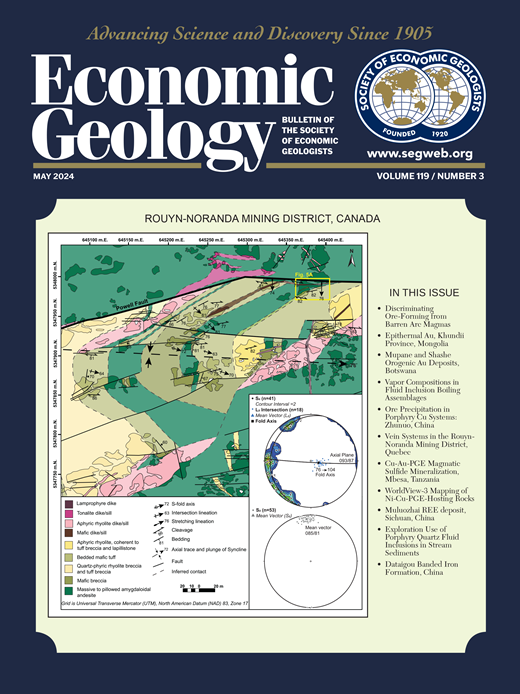基克拉迪斯大陆弧后多金属矿脉中热液重晶石的成因及碳酸盐岩矿床
IF 4.9
1区 地球科学
Q1 GEOCHEMISTRY & GEOPHYSICS
引用次数: 0
摘要
希腊基克拉泽斯大陆弧后的多金属脉体、角砾岩和碳酸盐岩替代矿床是由一系列流体和金属来源形成的,这些流体和金属来源受到晚中生代-新生代希腊俯冲体系动力学的强烈影响。这些复杂性记录在热液重晶石的同位素特征中。我们调查了基克拉迪群岛的四个岛屿和大陆的拉夫里翁的17个矿产地。在这里,重晶石几乎存在于中新世至第四纪的所有矿床类型中。我们采用多同位素和地球化学方法对各矿床的重晶石进行了表征,包括δ34S和δ18O的矿物分离分析和87Sr/86Sr和δ34S的激光烧蚀-电感耦合等离子体质谱分析。含碳酸盐矿脉和角砾岩铅锌银成矿重晶石的δ34S值(2 ~ 20‰)和δ18O值(10 ~ 15‰)变化范围广,反映了岩浆液和地表流体与碳酸盐岩中同位素重氧交换的混合作用。含碳酸盐脉铁重晶石的硫(δ34S = 10-13‰)和氧(δ18O = 9-13‰)值允许岩浆硫酸盐组分存在。Milos浅成热液基岩和(或)贵金属重晶石的δ34S(17-28‰)和δ18O(9-11‰)值与现代海水相似。而安提帕罗斯和米科诺斯脉状矿床的重晶石δ34S值(16 ~ 37‰)和δ18O值(4 ~ 12‰)变化范围较广,表明其为热液流体与主岩混合或平衡后的海水硫酸盐源。重晶石锶同位素比值区域性差异较大,基克拉底中部87Sr/86Sr≥0.711,西基克拉底87Sr/86Sr≤0.711,证实了上部地壳岩石对矿石形成过程中流体来源、Sr和Ba的强烈影响。本文章由计算机程序翻译,如有差异,请以英文原文为准。
Origin of Hydrothermal Barite in Polymetallic Veins and Carbonate-Hosted Deposits of the Cyclades Continental Back Arc
Abstract Polymetallic veins and breccias and carbonate-replacement ore deposits in the Cyclades continental back arc, Greece, formed from a range of fluid and metal sources strongly influenced by the dynamics of the late Mesozoic-Cenozoic Hellenic subduction system. These complexities are recorded in the isotopic signatures of hydrothermal barite. We investigated 17 mineral occurrences on four Cycladic islands and from Lavrion on the mainland. Here, barite occurs in almost all deposit types of Miocene to Quaternary age. We used a multiple isotope and geochemical approach to characterize the barite in each deposit, including mineral separate analysis of δ34S and δ18O and laser ablation-inductively coupled plasma-mass spectrometry of 87Sr/86Sr and δ34S. Barite from carbonate-hosted vein and breccia Pb-Zn-Ag mineralization on Lavrion has a wide range of δ34S (2–20‰) and δ18O (10–15‰) values, reflecting a mix of magmatic and surface-derived fluids that have exchanged with isotopically heavy oxygen in the carbonate host rock. Sulfur (δ34S = 10–13‰) and oxygen (δ18O = 9–13‰) values of barite from the carbonate-hosted vein iron and barite mineralization on Serifos are permissive of a magmatic sulfate component. Barite from epithermal base and/or precious metal deposits on Milos has δ34S (17–28‰) and δ18O (9–11‰) values that are similar to modern seawater. In contrast, barite from vein-type deposits on Antiparos and Mykonos has a wide range of δ34S (16–37‰) and δ18O (4–12‰) values, indicating a seawater sulfate source modified by mixing or equilibration of the hydrothermal fluids with the host rocks. Strontium isotope ratios of barite vary regionally, with 87Sr/86Sr ≥ 0.711 in the central Cyclades and 87Sr/86Sr ≤ 0.711 in the west Cyclades, confirming the strong influence of upper crustal rocks on the sources of fluids, Sr, and Ba in the formation of ore.
求助全文
通过发布文献求助,成功后即可免费获取论文全文。
去求助
来源期刊

Economic Geology
地学-地球化学与地球物理
CiteScore
10.00
自引率
6.90%
发文量
120
审稿时长
6 months
期刊介绍:
The journal, now published semi-quarterly, was first published in 1905 by the Economic Geology Publishing Company (PUBCO), a not-for-profit company established for the purpose of publishing a periodical devoted to economic geology. On the founding of SEG in 1920, a cooperative arrangement between PUBCO and SEG made the journal the official organ of the Society, and PUBCO agreed to carry the Society''s name on the front cover under the heading "Bulletin of the Society of Economic Geologists". PUBCO and SEG continued to operate as cooperating but separate entities until 2001, when the Board of Directors of PUBCO and the Council of SEG, by unanimous consent, approved a formal agreement of merger. The former activities of the PUBCO Board of Directors are now carried out by a Publications Board, a new self-governing unit within SEG.
 求助内容:
求助内容: 应助结果提醒方式:
应助结果提醒方式:


